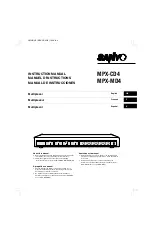
DIGITAL MULTIMETER
OPERATION MANUAL
1. GENERAL
This digital multimeter is a steady performance, battery-driven 4 1/2
digital multimeter. It uses the LCD with 28mm high figure to make the reading
clear and make operation more convenient.
The digital multimeter has the function of measuring DCV, ACV, DCA, ACA,
resistance, capacitance, transistor and diode, and continuity performance test,
etc. The meter can provide functions including unit symbol display, data
holding, It adopts double integral A/D converter as its core. It is an ideal
tool for labs, factories and radio-technology.
2. SAFETY
The instrument is designed according to IEC1010 standard (safety standard
issued by International Electro technical Committee). Please read the safety
note before operation.
2-1. Do not input a limited voltage higher than DC 1000V or AC 750V when
measuring ranges.
2-2. The voltage below 36V is safety. To avoid electric shock, check whether
the test leads are connected correctly, whether the insulation is good when
measuring over 36DCV or 25ACV.
2-3. The test leads should be removed from the testing point when changing
function and range.
2-4. Choose correct function and range to avoid wrong operation.
2-5. Do not input current higher than 20A when measuring current.
2-6. Specification of safety signal
“
” existing dangerous volt “
” GND “
”dual insulation
“
” operator must refer to the manual “
”low battery indication
3. SPECIFICATION
3-1.GENERAL
3-1-1. Displaying: LCD display
3-1-2. Max. displaying:19999(4 1/2)auto-polarity display
3-1-3. Measuring method:dual-slope A/D transfer
3-1-4. Sampling rate:approx. 3 times/sec
3-1-5. Over-range display: “1” or “-1”displayed in the highest digit.
3-1-6. Low battery display:“
” displays
3-1-7. Operation :(0~40)℃,relative humidity <80% R.H
3-1-8. power: 9V battery (NEDA1604/6F22 or equivalent)
3-1-9. Dimension: 185mm×93mm×35 mm
3-1-10. Weight: approx. 290g (including battery)
3-1-11. Accessories: user manual, test leads, holster, gift box, and 1*9V
battery.
3-2.TECHNICAL SPECIFICATION
3-2-1. Accuracy: ±(a% × reading+digits)at 23 ± 5℃,<75% R.H,one year
guarantee from production time.
3-2-2.DCV
Range
Accuracy
Resolution
200mV
10uV
2V
100uV
20V
1mV
200V
±(0.1%+5)
10mV
1000V
±(0.2%+5)
100mV
Input impedance:10MΩ at all ranges
Over-range protection:250 DCV or AC peak value at 200mV range,
1000 DCV or DC peak value at other range
3-2-2.AC
Range
Accuracy
Resolution
2V
100uV
20V
1mV
200V
±(0.8%+25)
10mV
750V
±(1.0%+25)
100mV
Input impedance:10MΩ at all ranges
Over-range protection:1000 DCV or DC peak value at other range
Frequency response:below 200V:40~400Hz,750Vrange:40~200Hz
Displaying:sine wave RMS(mean value response )
3-2-3.DCA
Range
Accuracy
Resolution
200uA
0.01uA
2mA
0.1uA
20mA
±(0.5%+4)
1uA
200mA
±(0.8%+6)
10uA
20A
±(2.0%+15)
1mA
Max. measuring volt drop: 200mV
Max. input current: 20A(less than10 seconds)
Overload protection: 0.2A / 250V fast blow fuse; 20A range without fuse.
3-2-4.ACA
Range
Accuracy
Resolution
200mA
±(1.5%+25)
10uA
20A
±(2.5%+35)
1mA
Max. measuring volt drop:200mV
Max. input current:20A(less than 10 seconds)
Overload protection: 0.2A / 250V with fuse,20A range without fuse.
Frequency response:40~200Hz
Displaying:sine wave RMS(mean value response)
3-2-5. RESISTANCE(Ω)
Range
Accuracy
Resolution
200Ω
±(0.2%+10)
0.01Ω
2kΩ
0.1Ω
20kΩ
1Ω
200kΩ
10Ω
2MΩ
±(0.2%+5)
100Ω
20MΩ
±(0.8%+15)
1kΩ
Open circuit voltage:less than 3V;
Overload protection:250DCV or ACV peak value;
Note:
In 200Ω range , should make the test leads short, and measure the
resistance of the wire, then, subtracts from the actual measuring value.
3-2-6. Conductance(resistance range:10,000MΩ-10MΩ)
Range
Accuracy
Resolution
(0.1-100)nS
±(1.0+5)
nS
Open circuit voltage:less than 3V;
3-2-7.CAPACITANCE
Range
Accuracy
Resolutio
20nF
1pF
2uF
±(3.5%+10)
100pF
200uF
±(3.8%+20)
10nF
Testing frequency: 400Hz;
Overload protection:36 DCV or ACV peak value.
3-2-8.FREQUENCY
Range
Accuracy
Resolutio
2kHz
0.1Hz
200kHz
±(3.0%+15)
10Hz
Input sensitivity:1V RMS;
Overload protection:250V DC or AC peak value (less than 10sec.).
3-2-9.DIODE AND CONTINUITY TEST
RANGE
DISPLAYING VALUE
TEST CONDITION
Diode forward volt drop
Forward DC current is
approx. 1mA , backward
voltage is approx. 3V
Buzzer rings, the impedance
between the two testing points
is less than(30±10)Ω
Open voltage is approx.
3V
Overload protection:250DCV or ACV peak value;
Warning: do not input any voltage value at this range for safety!
3-2-10. hFE
Range
Scope
Testing condition
hFE NPN or PNP
0~1000
Base DC current is approx.
10uA,V
ce
is approx. 3V
4.OPERATION
4-1.Front panel
①. LCD: display the measured value;
②Function key;
②-1. Power switch: turn on or off the power
②-2. HOLD key: press the key down, the measured value
will be hold and “HOLD” signal appears; press it
down again,“ HOLD ”signal disappears and out of
the HOLD mode.
②. Backlight;
③.hFE testing terminal:for measuring transistor
hFE;
④.Knob switch: for changing function and range;
⑤.Terminal for capacitance;
⑥.Terminal for Voltage, resistance, frequency and GND testing;
⑦.Battery case;
4-2.DCV measurement
4-2-1. Apply the black test leads to “COM” terminal and the red one to V/Ω/Hz
terminal.
4-2-2. Switch the knob to a proper DCV range, then, connect the test leads cross
the measured circuit, the voltage and polarity of the point which connected
with the red test lead will be displayed.
NOTE:
1. If the voltage under measured is unclear beforehand, should set the range
knob to the highest range, then, switch to a proper range according to the
displaying value..
2. The remained digits do not affect on measuring accuracy when we haven’t




















